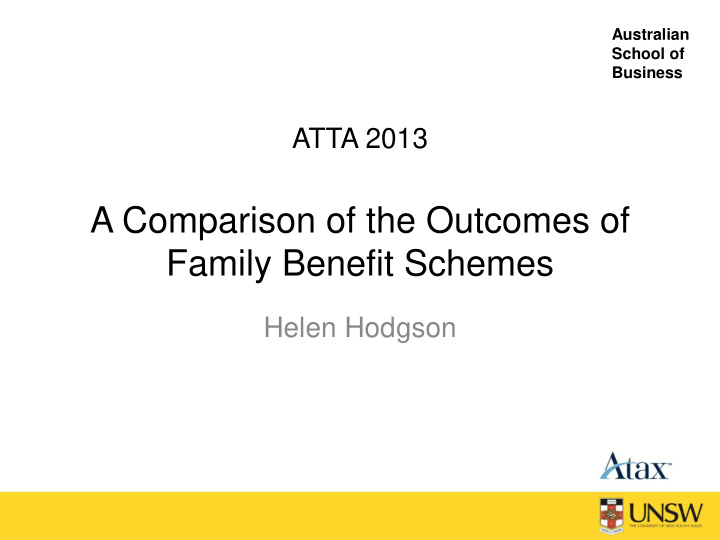



Australian School of Business ATTA 2013 A Comparison of the Outcomes of Family Benefit Schemes Helen Hodgson
Australian Policy Goals School of Business • Structural Issues in the tax transfer system • Horizontal Equity • Assist with cost of raising children • Horizontal Equity • Anti Poverty Measures • Vertical Equity/Redistribution • “Family Policies”
Australian Evaluating Outcomes School of Business • Child Poverty Rates • Family Joblessness • Female Workforce Participation • Inequality measures • Pre/post transfers
Australian Key Resources School of Business OECD Database: OECD.Stat OECD. (2008) Growing Unequal? Income Distribution and Poverty in OECD Countries. Paris: OECD. OECD. (2011) Doing Better for Families. OECD Publishing. OECD (2012). Gender Equality in Education, Employment and Entrepreneurship: Final Report to the MCM 2012. Paris, OECD. Luxembourg Income Study: LISdatacenter.org but NZ not included
Australian Inequality Measures: Gini index School of Business 0.55 0.5 Australia before tax/transfers 0.45 0.4 New Zealand before 0.35 tax/transfers 0.3 Australia after tax/transfers 0.25 0.2 New Zealand after tax/transfers Early Australian data not in OECD series (ABS used) • Inequality has risen in both countries before tax/transfers. • NZ has drop from mid 1990s compared to Australia •
Australian OECD Measures: Mid 2000s School of Business GINI P90/P10 P50/P10 Value Rank Shift Value Rank Shift Value Rank 90s 90s NZ 0.34 23 0.0 4.27 19 0.2 2.06 16 Aus. 0.30 16 -0.8 3.95 15 -0.1 2.09 18 OECD Growing Unequal Table 1.A2.2 1.A2.4 • P50/P10 not available • Ranked out of 30, most equal to least equal •
Australian Population receiving < 50% mean income School of Business 35 30 25 Australia 20 before taxes and transfers 15 NZ before taxes and 10 transfers 5 Australia after taxes and 0 transfers NZ after taxes and transfers
Australian Child Poverty Rates School of Business Poverty among Poverty in households with children children All Single Couple Point changes Level, mid-2000s Mid- Level, chang since Two and 2000s mid- e from Not No One mid- working Working more 2000s 1995 workers worker 1990s workers Australia 12 -1.2 10 -1.0 68 6 51 8 1 NZ 15 2.3 13 1.5 48 30 47 21 3 OECD 13 0.6 11 0.3 58 18 49 14 2 Child poverty linked to - Joblessness - Sole parent - Inadequate wages
Australian Unemployment & Wages School of Business 18 16 Low Pay Incidence: 14 Australia 12 Low Pay Incidence: 10 NZ Australia 8 unemployment 6 New Zealand 4 unemployment 2 0 1970 1980 1990 2000 2010 Low Pay Incidence = % earning less than 2/3 median annual wage • Australia higher low pay incidence from 2000 & unemployment •
Australian Unemployment: School of Business Duration as % of unemployed: 100% 90% over 1 year 80% 70% 6 to 12 months 60% 3 to 6 months 50% 40% 1 to 3 months 30% 20% < 1 month 10% 0%
Australian Demographic Change School of Business • Similar in both countries • Increasing rates of sole parents • Higher in NZ: 24% v 17% • Projections up to 30% by 2030 • Smaller families • Later child birth • Cohabitation rates increased compared to formal marriage • Increased female participation in workforce • About 70% • 2/3 part time
Australian Political & Institutional Factors School of Business Australia New Zealand 1975 Coalition: Fraser 1975 National: Muldoon 1983 Labor: Hawke 1984 Labour: Lange 1990 National: Bolger 1996 Coalition: Howard 1999 Labour: Clarke 2007 Labour: Rudd 2008 National: Key • NZ in coalition since 1996 • Similar trends in governing party in each country
Australian Observations: School of Business 1. Trends very similar in the 2 countries 2. NZ performs slightly better than Australia on most measures, but timing issues – Bigger gap between highest and lowest earners 3. Neither country has any universal family benefit remaining 4. Australia retains “modified universal” family benefit system through base level benefit (up to about 2 x average earnings) 5. Argument in NZ centres around horizontal equity & universal benefit rather than vertical equity
Recommend
More recommend